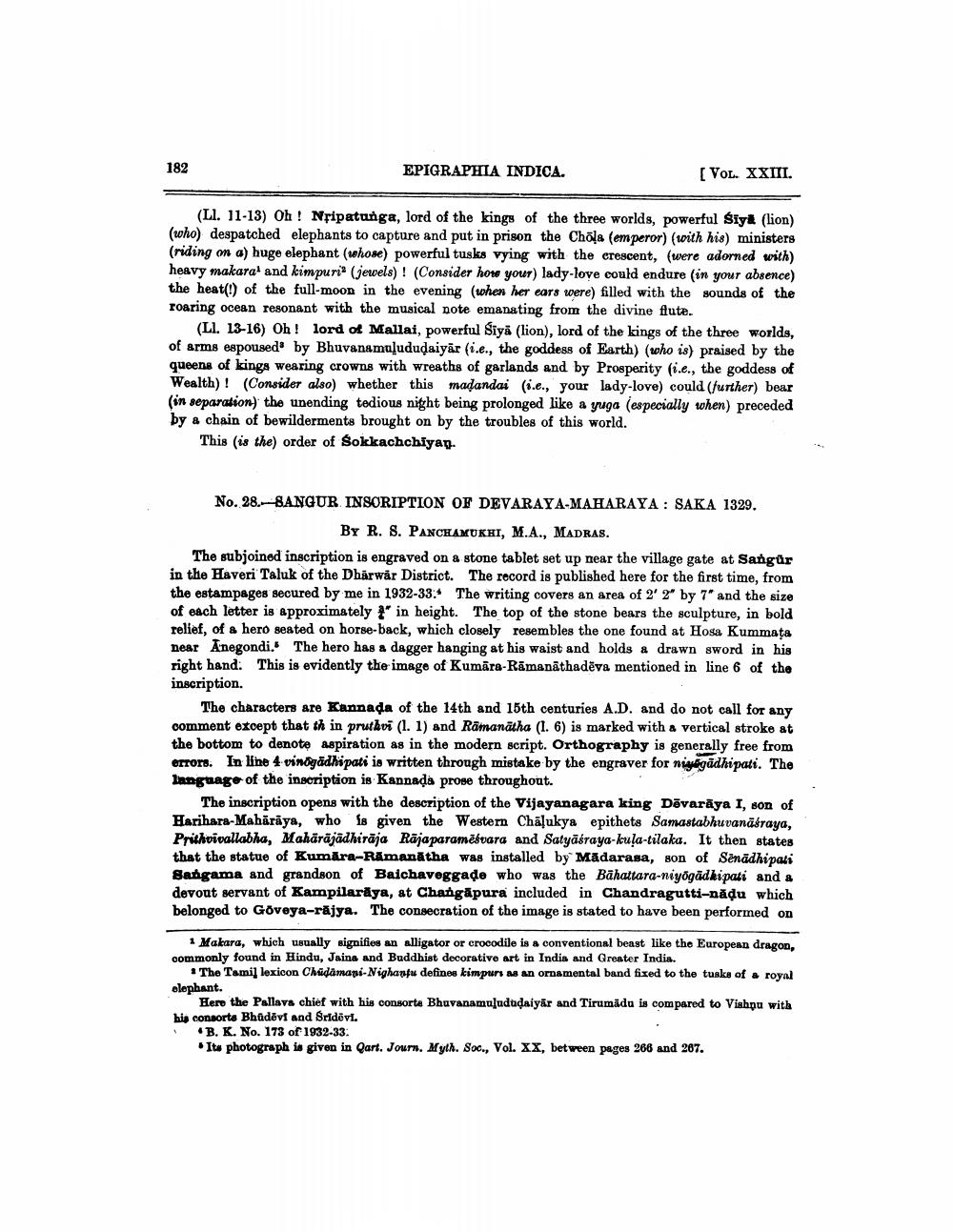________________
182
EPIGRAPHIA INDICA.
[VOL. XXIII.
(Ll. 11-13) Oh! Nripatunga, lord of the kings of the three worlds, powerful Siya (lion) (who) despatched elephants to capture and put in prison the Chola (emperor) (with his) ministers (riding on a) huge elephant (whose) powerful tusks vying with the crescent, (were adorned with) heavy makara1 and kimpuri (jewels)! (Consider how your) lady-love could endure (in your absence) the heat(!) of the full-moon in the evening (when her ears were) filled with the sounds of the roaring ocean resonant with the musical note emanating from the divine flute.
(Ll. 13-16) Oh lord of Mallai, powerful Siya (lion), lord of the kings of the three worlds, of arms espoused by Bhuvanamulududaiyar (i.e., the goddess of Earth) (who is) praised by the queens of kings wearing crowns with wreaths of garlands and by Prosperity (i.e., the goddess of Wealth)! (Consider also) whether this madandai (i.e., your lady-love) could (further) bear (in separation) the unending tedious night being prolonged like a yuga (especially when) preceded by a chain of bewilderments brought on by the troubles of this world.
This (is the) order of Sokkachchiyan.
No. 28. SANGUR INSCRIPTION OF DEVARAYA-MAHARAYA: SAKA 1329.
BY R. S. PANCHAMUKHI, M.A., MADRAS.
The subjoined inscription is engraved on a stone tablet set up near the village gate at Sangür in the Haveri Taluk of the Dharwar District. The record is published here for the first time, from the estampages secured by me in 1932-33: The writing covers an area of 2' 2" by 7" and the size of each letter is approximately 2" in height. The top of the stone bears the sculpture, in bold relief, of a hero seated on horse-back, which closely resembles the one found at Hosa Kummața near Anegondi. The hero has a dagger hanging at his waist and holds a drawn sword in his right hand. This is evidently the image of Kumara-Ramanathadeva mentioned in line 6 of the inscription.
The characters are Kannada of the 14th and 15th centuries A.D. and do not call for any comment except that th in pruthvi (1. 1) and Ramanatha (1. 6) is marked with a vertical stroke at the bottom to denote aspiration as in the modern script. Orthography is generally free from errors. In line 4 vinogadhipati is written through mistake by the engraver for niggadhipati. The language of the inscription is Kannada prose throughout.
The inscription opens with the description of the Vijayanagara king Dēvaraya I, son of Harihara-Maharaya, who is given the Western Chalukya epithets Samastabhuvanäsraya, Prithvivallabha, Mahäräjädhiraja Rajaparamesvara and Satyasraya-kula-tilaka. It then states that the statue of Kumara-Ramanatha was installed by Madarasa, son of Senādhipati Sangama and grandson of Baichaveggade who was the Bahattara-niyögädkipati and a devout servant of Kampilaraya, at Changapura included in Chandragutti-năḍu which belonged to Goveya-rajya. The consecration of the image is stated to have been performed on
1 Makara, which usually signifies an alligator or crocodile is a conventional beast like the European dragon, commonly found in Hindu, Jaina and Buddhist decorative art in India and Greater India.
The Tamil lexicon Chudamani-Nighantu defines kimpurs as an ornamental band fixed to the tusks of a royal elephant.
Here the Pallava chief with his consorte Bhuvanamuluduḍaiyar and Tirumādu is compared to Vishnu with his consorts Bhudevi and Sridevi.
B. K. No. 173 of 1932-33:
*Its photograph is given in Qart. Journ. Myth. Soc., Vol. XX, between pages 266 and 267.




